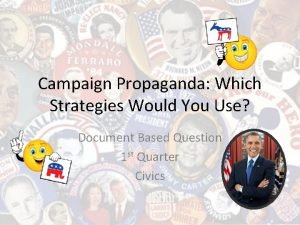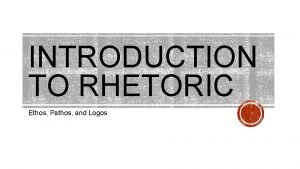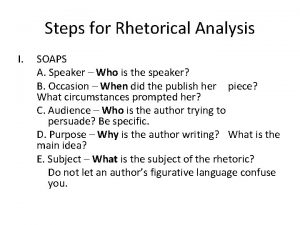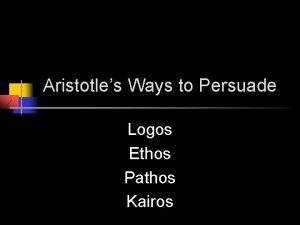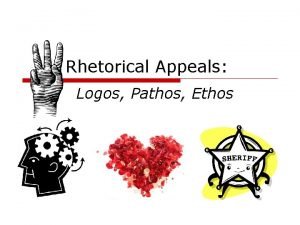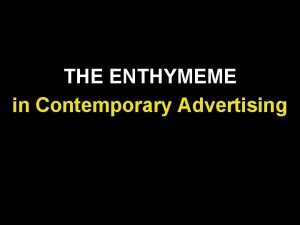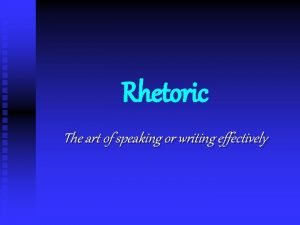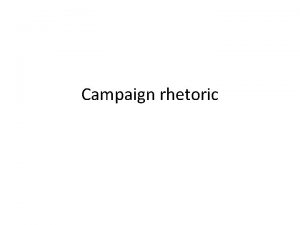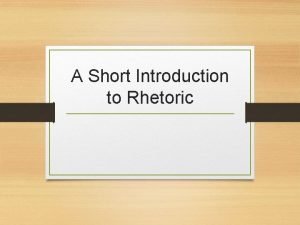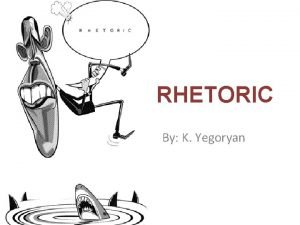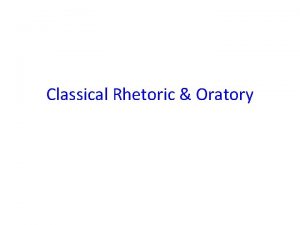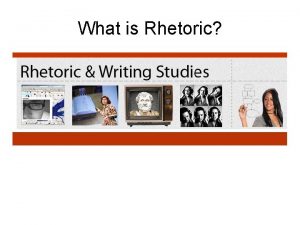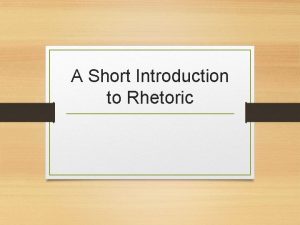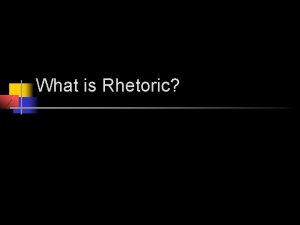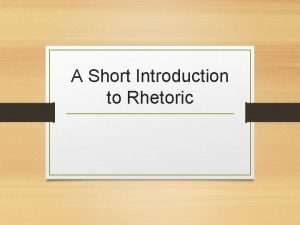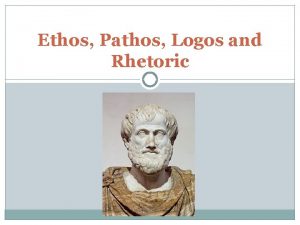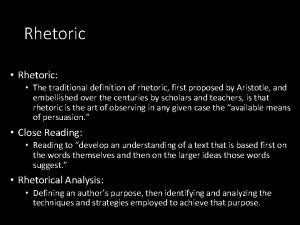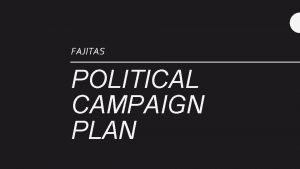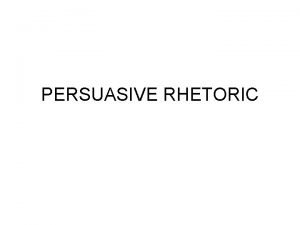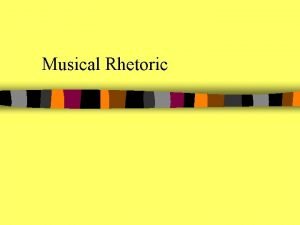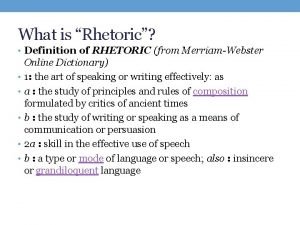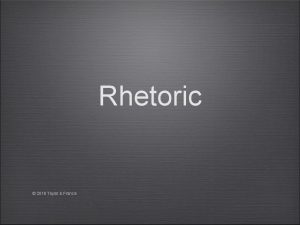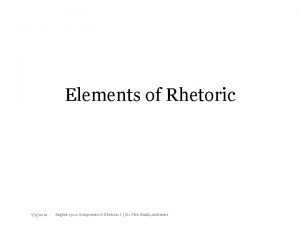Campaign Rhetoric Rhetoric Rhetoric is the use of



















































- Slides: 51

Campaign Rhetoric

Rhetoric • Rhetoric is the use of language to please or persuade (wordnetweb. princeton. edu) • The main focus of the study of rhetoric has been on public speaking with the intent to persuade an audience to accept the speaker’s position – Especially political speech

Another view • A more expansive view would see rhetoric as the study of the effective use of symbols

Political campaigns and rhetoric • One could argue that all persuasive strategies and tactics in campaign communication can be evaluated according to the scholarship of rhetoric – Theories and research on persuasion • Speechmaking is the topic most directly tied to traditional rhetoric

Ethics • Since at least as long ago as the ancient Greeks there has been an ethical debate over the use of various persuasive strategies – Outright lies – Misleading presentation – Failure to reveal pertinent information – Use of emotional arguments rather than logical ones

• On the other hand, use of noble, uplifting ideas to persuade may be an important contributor to laudable behavior or social betterment • Speeches allow the candidate to communicate directly with the electorate without the mediation of newspeople, spokespersons, etc. – An opportunity to inform, persuade and inspire the audience

Aristotle • Pathos—emotion • Ethos—speaker character • Logos—logic or reason

What factors affect persuasiveness? • • • Language use Visual imagery Framing Emotion Delivery Audience involvement/beliefs

Propaganda • Propaganda is persuasive media content

Institute for Propaganda Analysis • In the hope of reducing the impact of irrational propaganda on the populace in the wake of WWI, IPA was formed • A number of studies, articles meant to help people see through false and misleading presentation, critique propaganda

Seven propaganda devices • • Name calling Glittering generalities Transfer Testimonial Plain folks Card stacking Band wagon

• Rhetors use a number of techniques to connect their favored policies with beliefs that are widely revered and to connect those they oppose to ideas that are widely seen as evil or repugnant










Atrocity stories




Misrepresentation


Are misconceptions corrected over time? • Misconceptions about the health care bill are still circulating


Is emotion or logic more persuasive? • For most people most of the time, emotional appeals are more persuasive – Impact decreases as audience knowledge increases

The role of the audience • A strong tendency toward biased reception, retention – Ignore disconfirming evidence – Interpret ambiguous information as support – Consider sources that deliver information contrary to beliefs to be biased – Seek out confirmatory content, avoid disconfirmatory • Cable TV, Internet/Web have made this much easier

The role of the audience • Gain pleasure from group support, intellectual competition – More the case with committed partisans • May actively demonstrate support, chant with the speaker, boo the opposition, etc.

Existing knowledge • The more knowledgeable an individual is on a topic the less persuadable she is – Complicated and powerful schema • The less knowledgeable and individual is, the more persuadable he is, and the more peripheral cues are effective in persuasion

Framing • Constructing a larger worldview that sets the context for the interpretation of events, people, issues and issue positions, etc. • Once in place it is hard to change both at the individual and aggregate levels – Pro Choice v. Pro Life • Frames are constructed through rhetoric and invoked through language


Lakoff • The Difference Between Framing and Messaging • “Framing is the most commonplace thing we do with thought and language. Frames are the cognitive structures we think with. They are physical, embodied in neural circuitry. Frames come in systems. Their circuitry is strengthened and often made permanent through use: the more the circuits are used, the stronger they get. Effective frames are not isolated. They build on, and extend, other frames already established. All words are defined in terms of conceptual frames. When the words are heard, the frames are strengthened -- not just the immediate frames, but the whole system. ”

• • • High-level, moral frames matter more Most framing is unconscious Framing is long-term Prototype frames Bi-conceptual frames – Contested concepts

• According to Lakoff, opinion differences between liberals and conservatives “follow from the fact that they subscribe with different strength to two different metaphors about the relationship of the state to its citizens. ” Both see governance through “metaphors of the family. ”

• “Conservatives would subscribe more strongly and more often to a model that he calls the "strict father model" and has a family structured around a strong, dominant "father" (government), and assumes that the "children" (citizens) need to be disciplined to be made into responsible "adults" (morality, self-financing). Once the "children" are "adults", though, the "father" should not interfere with their lives: the government should stay out of the business of those in society who have proved their responsibility. ”

• “In contrast, Lakoff argues that liberals place more support in a model of the family, which he calls the "nurturant parent model", based on "nurturant values", where both "mothers" and "fathers" work to keep the essentially good "children" away from "corrupting influences" (pollution, social injustice, poverty, etc. ). Lakoff says that most people have a blend of both metaphors applied at different times, and that political speech works primarily by invoking these metaphors and urging the subscription of one over the other. ”

• Current frames – “Tax and spend liberals” • “Socialism” – “Tea Party patriots” – “War on Terrorism” – “War on Drugs” – “Illegal aliens” – “Bailout”

Goals of public speeches • Provide important information to the audience • Persuade listeners to prefer you to your opposition – Generate a positive view of yourself – Generate a negative view of your opponents • Generate media coverage – Sound bites that further your campaign

Major speech forms (Trent) • • Announcement speech Nomination acceptance speech News conferences Apologia • Why I’m Running

Announcement speech • Goals: – Clearly signals candidate’s intention to run – May serve to discourage competition – Indicate why the candidate is running – Initiate themes of the campaign • Strategies – Timing – Place – Who do you share the spotlight with? – Content

Announcement speech content • Three typical themes: – Candidates announce that they are, in fact, running – They explain why they are running – They suggest the likelihood of their victory

Timing of announcement • Hagel • Obama

Follow-up • Publicity-gaining strategies – Walking tour of state (Missouri governor “Walking Joe” Teasdale) – Follow-up communications – Endorsements – Travels • Kucinich “reannouncement tour”

Acceptance address • Goals/purposes of the address – The candidate publicly assumes the role of a candidate/leader of the party – Generate a strong positive response from the immediate audience – Unify the party – Serve as a strong persuasive message • Immediate audience • Remote audience (TV)

Acceptance strategies • Simplified partisan statements • Laments about the present and celebrations about the future • Stress on the crucial nature of the election • Attempts to seek support from the entire constituency • Using biography • Comparison with opponent

Apologia • Goals – Explain statement or behavior that casts doubts on the suitability of the candidate • Explain the behavior or statement in a positive light • Justify the behavior • Remove the topic from public discussion

Apologia strategies • Control of the setting • Denial • Bolstering – Identify with something the audience values • Differentiation – Attack the source – Separate some piece of the story from the accusation • Transendental strategy – Move audience away from the specifics of the case to some higher plane of discussion • Confession
 Gray propaganda meaning
Gray propaganda meaning Làm thế nào để 102-1=99
Làm thế nào để 102-1=99 Thiếu nhi thế giới liên hoan
Thiếu nhi thế giới liên hoan Vẽ hình chiếu vuông góc của vật thể sau
Vẽ hình chiếu vuông góc của vật thể sau Bài hát chúa yêu trần thế alleluia
Bài hát chúa yêu trần thế alleluia Một số thể thơ truyền thống
Một số thể thơ truyền thống Hệ hô hấp
Hệ hô hấp Công thức tính thế năng
Công thức tính thế năng Các số nguyên tố là gì
Các số nguyên tố là gì Tỉ lệ cơ thể trẻ em
Tỉ lệ cơ thể trẻ em đặc điểm cơ thể của người tối cổ
đặc điểm cơ thể của người tối cổ Các châu lục và đại dương trên thế giới
Các châu lục và đại dương trên thế giới ưu thế lai là gì
ưu thế lai là gì Thẻ vin
Thẻ vin Môn thể thao bắt đầu bằng từ chạy
Môn thể thao bắt đầu bằng từ chạy Tư thế ngồi viết
Tư thế ngồi viết Cái miệng nó xinh thế
Cái miệng nó xinh thế Hình ảnh bộ gõ cơ thể búng tay
Hình ảnh bộ gõ cơ thể búng tay Từ ngữ thể hiện lòng nhân hậu
Từ ngữ thể hiện lòng nhân hậu Trời xanh đây là của chúng ta thể thơ
Trời xanh đây là của chúng ta thể thơ Tư thế ngồi viết
Tư thế ngồi viết Gấu đi như thế nào
Gấu đi như thế nào Thế nào là giọng cùng tên?
Thế nào là giọng cùng tên? Thể thơ truyền thống
Thể thơ truyền thống Sự nuôi và dạy con của hổ
Sự nuôi và dạy con của hổ đại từ thay thế
đại từ thay thế Thế nào là hệ số cao nhất
Thế nào là hệ số cao nhất Diễn thế sinh thái là
Diễn thế sinh thái là Vẽ hình chiếu vuông góc của vật thể sau
Vẽ hình chiếu vuông góc của vật thể sau Thế nào là mạng điện lắp đặt kiểu nổi
Thế nào là mạng điện lắp đặt kiểu nổi Mật thư anh em như thể tay chân
Mật thư anh em như thể tay chân Lời thề hippocrates
Lời thề hippocrates Vẽ hình chiếu đứng bằng cạnh của vật thể
Vẽ hình chiếu đứng bằng cạnh của vật thể Tư thế worms-breton
Tư thế worms-breton Quá trình desamine hóa có thể tạo ra
Quá trình desamine hóa có thể tạo ra Sự nuôi và dạy con của hươu
Sự nuôi và dạy con của hươu Dot
Dot điện thế nghỉ
điện thế nghỉ Các châu lục và đại dương trên thế giới
Các châu lục và đại dương trên thế giới Bổ thể
Bổ thể Nguyên nhân của sự mỏi cơ sinh 8
Nguyên nhân của sự mỏi cơ sinh 8 Phản ứng thế ankan
Phản ứng thế ankan Anecdote ethos pathos logos
Anecdote ethos pathos logos Soaps rhetoric
Soaps rhetoric Logos ethos pathos kairos
Logos ethos pathos kairos Pick it up rhetoric
Pick it up rhetoric Ethos logos pathos
Ethos logos pathos Logos example
Logos example Enthymemes in advertising
Enthymemes in advertising Rhetorical stance
Rhetorical stance Is the art of speaking or writing effectively.
Is the art of speaking or writing effectively.
